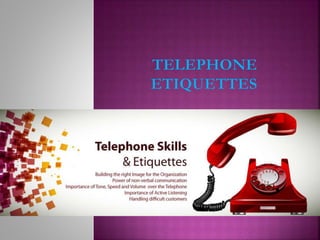
Telephone etiquettes upload
- 2. • Be prepared – plan your conversation • Turn away from your computer desk or other work • Have pens, pencils and notepaper handy.
- 3. Smile as soon as customer picks the phone – Customer will hear it in your voice. Project a tone that is enthusiastic, natural, attentive and respectful. Greet the customer and identify yourself and your business
- 4. • Enunciate / pronounce clearly • Use simple English • Avoid slang – uh, hmm, yeah, dude • Always speak calmly and choose your words carefully • Use all your listening skills • Focus all your attention on the caller and the conversation • Clarify and check for understanding • Use basic phrases of courtesy E.g. “May I help you?” “Please”, “Thank You”, “You are welcome”. • Do not chew gum or eat during a conversation • Do not slam the phone or cut off abruptly • Refrain from idle chit chat with customers.
- 5. If there is a problem, project a tone that is concerned, empathetic and apologetic. Avoid the five forbidden phrases: • “No” - Instead find a way to state the situation positively • “I don’t know” - instead say “that is a good question let me find out for you” • “I/we can’t do that” - instead say “this is what I/We can do” • “You will have to” - instead say “here is how we can help you” • “Just a second” - instead give a more honest estimate of how long it will take you.
- 6. • Make sure that it is for a genuine reason. • Ask the customer if he/she would hold, and wait for a response rather than assuming the answer is yes. • Never keep a customer on hold for more than 30secs. If you have to take longer than that, return to the person and tell them that you will have to take some more time and ask if you could call back. • When you return to the customer, thank him/her for holding
- 7. • Listen; allow the customer to vent • Empathize; acknowledge the person’s feelings • Apologize when appropriate. • Be positive • Solve / suggest generate solutions that you can both agree on and if reasonable do it. • Remain calm and courteous, do not argue. • Do not interrupt. • Explain clearly do not make unrealistic promises. • Act fast, acting quickly shows that you are sorry and that you will handle the issue. • Follow up get back to the customer to make sure the problem has been solved.
- 8. • End the conversation with an agreement on what is to happen next; if you are to follow up do so immediately. • Thank the customer - for his time, invite the customer to shop again.
- 10. • Listening is hard work • Competition • The rush for action • Speed differences in the rate of speaking and understanding. Lack of training
- 11. • The Non-Listener HEARING • The Marginal Listener • V/s • The Evaluative Listener The Active Listener LISTENING
- 12. • Maintain eye contact with the instructor • Focus on content than on the way that it is being said. • Avoid selective listening • Avoid distractions • Ask questions to stay active and interested. • Face the speaker • Maintain eye contact • Respond appropriately – say yes, nod, etc. • Do not be preoccupied with your own thoughts.
- 14. CLOSE ENDED Generally result in short yes/no or other one word answers. They should be used only when you want precise, quick answers. Otherwise, they inhibit thought. OPEN ENDED They invite an actual explanation for a response. Questions that begin with “how”, “what” and “why” are typical open ended questions.
- 15. • When did that happen? • Was your trip successful? • Did you like the candidate? • Did you have a good meeting? • What led up to that? • What did you manage to accomplish on your trip? • In what ways do you think that candidate meets our need? • What happened at the meeting?
- 16. • Can you be more specific? • Can you give me an example of that? • What happened then? • How does this affect you? • What might cause that, do you think? • Can you fill me in on the details?
- 17. Open To Queries
